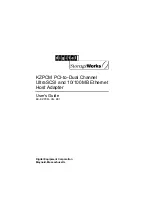
6 Hardware Information
6.1 Port Addressing
The QSP-200/300's four asynchronous serial ports are implemented using 4 standard 16C550
UARTs. Each of these UARTs requires 8 bytes of I/O space and when enabled which requires
the QSP-200/300 to be located on an even 32-byte (20H) boundary (e.g. 300H, 320H, 340H,
etc.).
Base A 24
Channel D
Base A 16
Channel C
Base A 8
Channel B
Base A 0
Channel A
Address assignment
QSP-200/300 channel
6.2 Scratchpad / Interrupt Status Register
Each 16C550 UART contains 8 I/O registers. The last of these registers, located at (Base address
+ 7), is referred to as the 'Scratchpad Register' and provides no functionality to the UART. In
place of this Scratchpad Register, the QSP-200/300 implements an interrupt status register which
can be accessed at (Base a 7) of any UART. The purpose of the interrupt status register
is to give the software programmer an easy way to inspect the interrupt state of the entire
QSP-200/300 with a single input operation. The format of the interrupt status register is shown
below:
Intr A
Intr B
Intr C
Intr D
0
0
0
0
D0
D1
D2
D3
D4
D5
D6
D7
When one or more UARTs have interrupts pending, the associated bit(s) in the interrupt status
register are set to logic 1. When all the pending interrupts have been serviced for a specific
UART, its interrupt status bit will be cleared to logic 0 automatically. When all the pending
interrupts from all UARTs have been serviced, the entire interrupt status register will return logic
0. The application program should not exit its interrupt service routine until all pending
interrupts from all channels have been serviced (interrupt status register = 0) or no additional
interrupts will be received.
If an application requires the UARTs' Scratchpad Registers, the interrupt status register can be
disabled. Disabling the interrupt status register is supported by the QSP-200/300 configuration
software, which is operating system dependent. Refer to the relevant operating system
installation section for specific usage of this feature.
QSP-200/300 User's Manual
35









































